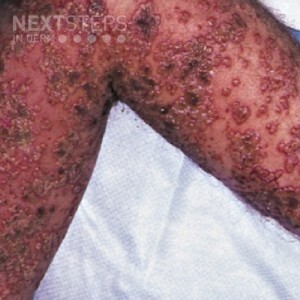
The correct answer is C. Polymerase chain reaction (PCR).
The correct answer is PCR. This patient has disseminated varicella zoster viral (VZV) infection. The rash has the classic ‘dew drop’ on a rose petal morphology (vesicles on an erythematous pink to red base). Sometimes, the vesicles can appear hemorrhagic, making diagnosis more challenging. Of all the testing options, PCR has the highest sensitivity (92.4-100% for fresh lesions, 80.7% for older lesions). The vesicle must be unroofed first, followed by rolling the swab on the base of the lesion.
TS is a rapid beside diagnostic tool. However, it cannot distinguish between herpes simplex and VZV. TS sensitivity is reported to be between 78.7-100% for 1 to 3 day old vesicles and 27-59.7% for older, crusted lesions. Viral culture has sensitivity of 46.3%, much lower than TS and PCR. DFA has a sensitivity of 87.8%, lower than PCR. Varicella zoster IgG would help determine prior infection and immunity.
References:
Wanat KA, Dominguez AR, Carter Z, Legua P, Bustamante B, Micheletti RG. Bedside diagnostics in dermatology: Viral, bacterial, and fungal infections. J Am Acad Dermatol. 2017;77(2):197-218. doi:10.1016/j.jaad.2016.06.034
Ozcan A, Senol M, Saglam H, et al. Comparison of the Tzanck test and polymerase chain reaction in the diagnosis of cutaneous herpes simplex and varicella zoster virus infections. Int J Dermatol. 2007;46(11):1177-1179. doi:10.1111/j.1365-4632.2007.03337.x
Durdu M, Baba M, Seçkin D. The value of Tzanck smear test in diagnosis of erosive, vesicular, bullous, and pustular skin lesions. J Am Acad Dermatol. 2008;59(6):958-964. doi:10.1016/j.jaad.2008.07.059
